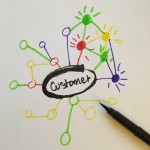How are we helping customers solve their problems in their terms?
How do you assemble your customer solution? Does it solve customer problems whilst freeing them to pursue their preferences? Or does it lock them into one single rigid process?
Nespresso makes home coffee machines without profit, in order to sell coffee capsules very profitably over the Internet. iTunes makes little profit on selling you back the music after purchasing the rights, but apple then makes a huge margin on the iPod – which also enables you to listen to music downloaded by other means. Similarly the iPhone is a high margin standard product, but infinitely customizable with it’s open app platform.
We used to think about products as solving customers’ problems. One product would compete against another or against another way of doing the same thing. But as digitalization opened up the world of connectivity, increasingly products are part of platforms that help customers assemble their solution out of a wide choice of elements.

This means shifting perspective from:
traditional marketing: making our best effort to offer customers our best solution to their imagined problems (often leveraging the technologies we know)
to:
platform thinking: developing complementary products and services customers themselves will assemble according to their use and needs.
In product development terms, this is a radical shift as it means looking completely different both at how people assemble complements and choose competing solutions but also understanding where the profitability comes from – not all the elements will be profitable.
The platform revolution has been going on in product development without many product developers noticing or getting wise. Get with the program: join the revolution! Change your thinking about how to help customers solve their problems autonomously rather than try to impose your preferred solution.









